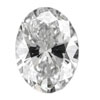|
The Pros and Cons of Oval-Cut Diamonds
|
|
On Thursday, February 21, 2019
|


If you want a classic engagement ring with some individual flair, consider an oval cut diamond. The oval cut originated in the 1960s so it is relatively new and gaining in popularity. Oval cut engagement rings have a number of advantages over the more familiar round cut diamond, although as with any precious stone, it’s important to know how to choose a good quality stone that is right for you.
So, what are the pros and cons of choosing oval shape diamond rings?
Pros
More affordable
An oval cut diamond will cost less than a round cut diamond of the same carat and clarity, so you can afford a bigger diamond for your budget. As an added bonus, the larger surface area of an oval cut diamond makes it look larger than a round cut of the same size, so this is a good affordable option if you prefer a setting with a large diamond.
More sparkle
A diamond’s sparkle and brilliance is determined by the way it is cut, and the oval cut is one of the brightest cuts of all. When you choose a ring with an oval cut center stone, you are guaranteed a brilliant sparkle on your finger.
Slimming effect on fingers
If you are looking for a slimming effect, the oval shape of the diamond can make a woman’s fingers look longer and thinner. Always experiment with different shaped stones before making your choice to ensure the shape of your ring complements your finger.
Doesn’t catch or scratch
There are no sharp corners on an oval cut diamond, so it is a great practical wear for every day. Any diamond with sharp corners is likely to catch on surfaces while you are performing routine tasks, leading to the risk of breaking the prongs which set the stone in place. An oval diamond’s prongs are far less likely to break than the prongs of a square cut diamond.
Your choice of settings
Not only is the oval-cut diamond a more original choice in itself, you can also choose from a variety of settings. With an oval-cut stone, you have the option of a 4-prong, 6-prong or bezel setting. A four-prong setting is less obtrusive, showcasing your diamond, and as the oval-cut is less likely to catch, the four prongs can be enough to hold it securely. The six-prong setting does offer the extra security of a firm hold, although a smaller diamond might be overshadowed by the additional metal. Alternately, a bezel setting is a strip of metal encircling the stone and holding it securely in place.
Cons
Bow tie effect
The primary concern with oval shape diamond rings is whether there is a noticeable “bow tie effect” in the diamond. With any fancy cut diamond, and particularly the oval cut, the light cannot distribute evenly throughout the diamond, causing the image of a bow tie in the center of the stone. Most oval cuts do exhibit the bow tie effect, although they are generally light and barely visible. It is important to check whether the bow tie effect will bother you before you purchase your stone.
Shows flaws
The oval cut does tend to highlight any flaws, blemishes and inclusions within the diamond, so you will need a clarity of VS1 or above and color of G and above to make the most of your purchase. The good news is that as oval shape diamond rings are cheaper than comparable round cuts, you can afford to invest in a higher clarity and color.
Overall, the oval cut diamond is an excellent option if you want a larger high-quality stone with plenty of extra sparkle at an affordable price. Take care to assess the color and clarity of your chosen diamond, and you will have a unique spectacular diamond ring.
|
|
|
|
Tags: oval diamonds, oval engagement rings, oval shape, oval cut
|
|
Category: Diamonds
|
|

|
|
